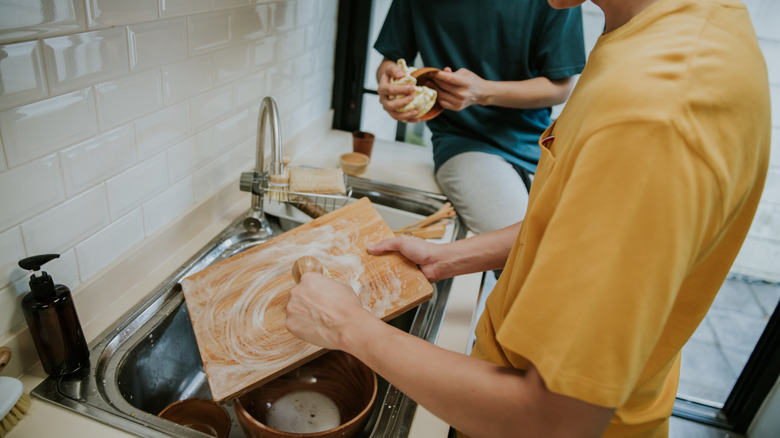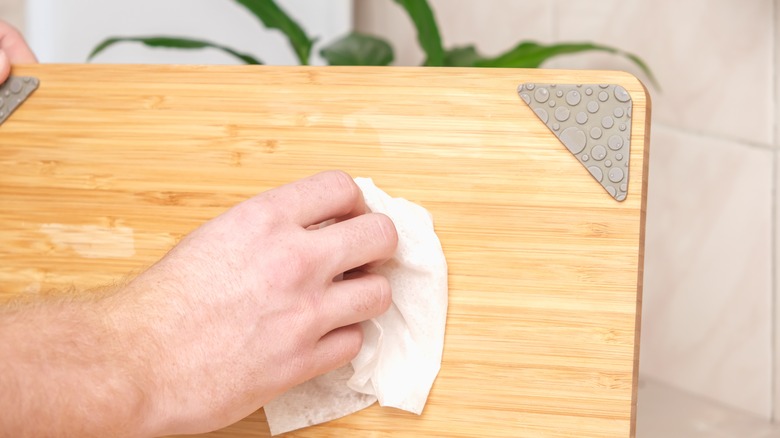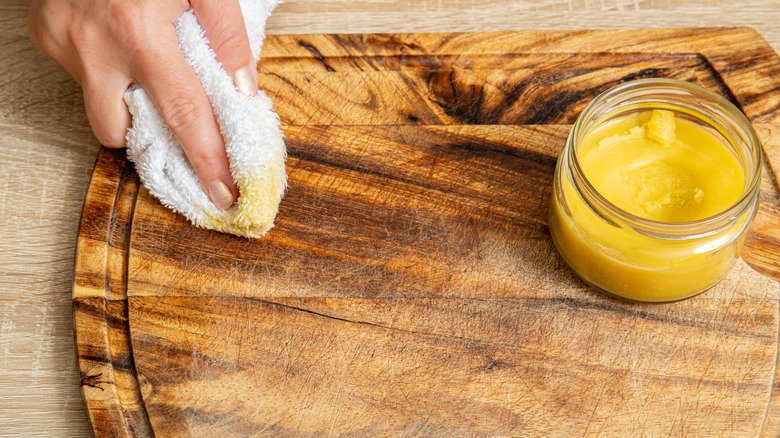This Cleaning Mistake Is Giving Your Wooden Kitchen Products A Funky Smell
Properly cleaning your wooden kitchen products, such as cutting boards, serving boards, and utensils, is essential for maintaining hygiene and preventing the growth of harmful bacteria or fungi. Wood is porous, allowing food particles and bacteria to seep into its surface, which can lead to contamination if not cleaned thoroughly. Regular cleaning with hot, soapy water and sanitizing with diluted vinegar or hydrogen peroxide helps eliminate pathogens and ensure food safety. While many use cooking oils derived from foods to polish or hydrate wooden kitchen products, this practice can actually lead to unpleasant odors over time as the oil spoils. When exposed to air and moisture, oils can become rancid, resulting in a foul smell that can transfer to food prepared on the wooden surface. Additionally, bacteria may thrive in the spoiled oil, exacerbating the risk of contamination.
The reason behind the spoilage of cooking oils on wooden surfaces lies in the porous nature of wood. The oil penetrates the wood fibers, providing a hospitable environment for bacteria and fungi to grow. As the oil oxidizes and decomposes, it releases compounds responsible for the unpleasant odor. This compromises the integrity of the wooden product and poses health risks. To avoid this issue, it's essential to refrain from using cooking oils on wooden kitchen products. Instead, opt for specialized wood conditioners or mineral oils specifically formulated for food contact. These products provide hydration and protection to your wood products without the risk of spoilage or foul odors.
Better oils to protect your wooden kitchen products
While standard cooking oils should be reserved for your meals, many products are safe to help maintain and preserve your wooden kitchen products. For starters, food-grade mineral oil is a popular choice for conditioning and polishing wooden kitchen products due to its non-toxic nature and ability to penetrate deep into the wood fibers. Unlike cooking oils, mineral oil is odorless, tasteless, and won't turn rancid over time. It helps to seal the wood, preventing moisture absorption and reducing the risk of cracks or warping. Food-grade mineral oil also enhances the natural beauty of the wood, leaving a smooth, glossy finish.
Secondly, beeswax polish is another excellent option for maintaining wooden kitchen products. It forms a protective barrier on the surface of the wood, repelling moisture and preventing drying or cracking. Beeswax also adds a lustrous shine to the wood, enhancing its appearance while providing long-lasting protection. Unlike cooking oils, beeswax polish does not become rancid or attract bacteria, ensuring the longevity and cleanliness of your wooden items.
Finally, carnauba wax, derived from carnauba palm leaves, is a natural and durable option for preserving wooden kitchen products. It offers superior water resistance and UV protection, making it ideal for items exposed to moisture and sunlight. Carnauba wax creates a hard, glossy finish on the wood, enhancing its durability and appearance. Like beeswax and mineral oil, carnauba wax will not go rancid either.
How to clean and polish your wooden kitchen products
Proper cleaning and polishing of wooden kitchen products are essential to prevent the development of a funky smell and to inhibit the growth of bacteria or fungi. Begin by cleaning your wooden item thoroughly after each use. Use hot, soapy water and a sponge or brush to scrub the surface, removing all food residues and stains. Avoid soaking wooden items for extended periods, as excessive moisture can promote bacterial growth and cause warping.
After cleaning, rinse your wooden product with clean water to remove any soap residue. Then, pat it dry with a clean towel or allow it to air dry completely in a well-ventilated area. Ensuring the wood is thoroughly dried helps prevent moisture from accumulating and creating a breeding ground for bacteria or fungi.
Once the wooden item is dry, it's important to polish and condition it regularly to maintain its appearance and integrity. Choose a suitable wood conditioner or polish specifically designed for kitchen use. Apply a small amount of the conditioner or polish onto a soft cloth and rub it evenly onto the surface of the wood, following the direction of the wood grain. Allow the conditioner or polish to penetrate the wood for the recommended time, typically around 15 to 20 minutes, before wiping off any excess. This process helps to hydrate the wood, seal the pores, and protect it from moisture and stains, enhancing the natural beauty of the wood with a smooth, glossy finish.


